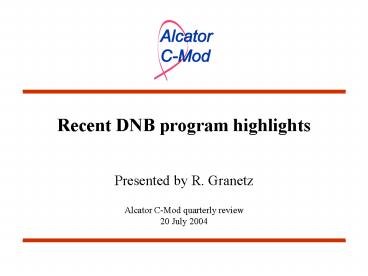Recent DNB program highlights PowerPoint PPT Presentation
1 / 15
Title: Recent DNB program highlights
1
Recent DNB program highlights
Presented by R. Granetz
Alcator C-Mod quarterly review 20 July 2004
2
Raw Angle Measured by MSE has Small Errors
o
- 1o deviations from exact linearity have clear
cos(2q) and cos(4q) components. - Simulated MSE spectra confirm that such errors
would be caused by mirror - imperfections phase shifts and non-equal S/P
reflectances. - The deviations are largest at the outermost and
innermost optical channels. - These small errors can be completely accounted
for in the analysis.
3
Error has cos(2q) and cos(4q) Components
- Phase shifts introduces cos(4q) error and S/P
reflectance ratio introduces cos(2q) - error.
- The dominant error is cos(4q) due to phase
shift. - Phase shift is largest for MSE channels at the
edge of the field-of-view, smallest - near the optical axis.
4
MSE Invessel Calibration Data is Understood
- Fits include corrections of order 1o caused by
phase shifts introduced by the three - MSE mirrors.
- Final system response is linear to within
0.02o across all channels. - System behavior during the invessel calibration
is fully understood (no - toroidal field, no vacuum, no atomic physics).
5
Anomalous Features of Beam-into-Gas Calibration
- Apply in-vessel calibration data to
beam-into-gas calibration shots. - Edge channels show significant curvature
response. - Slope of measured response is greater than
unity for all channels. - Offset exists for all channels.
6
Possible Causes of Observed Anomalies
- Atomic physics geometrical effects on Is/Ip
ratio - Unlike situation during in-vessel calibration,
the light emitted during - beam-into-gas shots has both s and p
components which are - orthogonal.
- The unusual viewing geometry of C-Mod MSE at
the plasma edge - may affect the Is/Ip ratio and the measured
angle. - Zeeman splitting of Stark Spectrum
- Magnetic field causes a small Zeeman splitting
of the Stark emission - spectrum with circular polarization.
- The phase shift induced by the MSE mirrors will
convert any circularly - polarized light into partially linearly
polarized light. - Faraday effect in MSE optical components
- MSE designed with low-Verdet glass. Faraday
effect expected to be small. - Will measure Verdet constant of MSE optical
components in the lab. - Stress-induced bi-refrigence of vacuum window
- Hard to reconcile with channel dependence of
MSE response.
7
We are currently between beams
- Alcator C-Mod had been using a short-pulse (50
ms) diagnostic neutral beam on temporary loan
from Consortio RFX (2 years) - 50 kV 4-5 amps ion current from source
- Arc discharge plasma source ? high full-energy
fraction (80 90) - Worked well, but only gave a single time point
during discharge - Loan period has expired, and the beam was
returned to RFX in May 2004
8
Typical DNB signals with RFX short-pulse beam
1 MA
ne 1.5?1020 m-3 (L-mode)
50 kV, 50 ms
4-5 amps ion current
Raw MSE signal
Raw BES signal
9
New long-pulse DNB being built for C-Mod by the
Budker Institute
- Beam specifications
- 1.5 s total beam on-time able to be fully
modulated (for example, with 50 duty factor,
beam pulse can cover 3 s discharge duration) - 55 kV, 8 amps ion current from source
- RF discharge plasma source is the baseline
design long lifetime, but with somewhat reduced
full-energy fraction (60 70) - A long-lifetime arc source is also being
developed as a possible alternative (higher
full-energy fraction). Excellent progress has
been made.
10
RF source vs arc source
- Arc sources produce hotter plasmas, and therefore
have a higher yield of full-energy ions
(i.e. H), which is an important consideration
for MSE. - 80-90 for arc source vs 60 for RF source
- But cold cathode arc sources suffer from
erosion of the cathode material. This limits the
source lifetime, or equivalently, the pulse
length. (Arcing at the surface of the cathode
produces electron emission, but also melting.)
Therefore, long-pulse diagnostic beams have used
RF sources
11
Budker beams with RF sources are used on TEXTOR
and TCV
- TEXTOR DNB
- 20 50 keV
- 2 amps
- 10 seconds
- 60 full-energy fraction (of ion current in
source)
- TCV DNB
- 20 55 keV
- 2.8 amps
- 2 seconds
- 60 full-energy fraction (of ion current in
source)
12
Arc plasma source with LaB6 cathode emitter
13
Prototype arc plasma source with LaB6 cathode
emitter
14
Energy components of beam using the prototype
LaB6 arc plasma source
15
Energy component mix vs time current (prototype
LaB6 arc plasma source)

